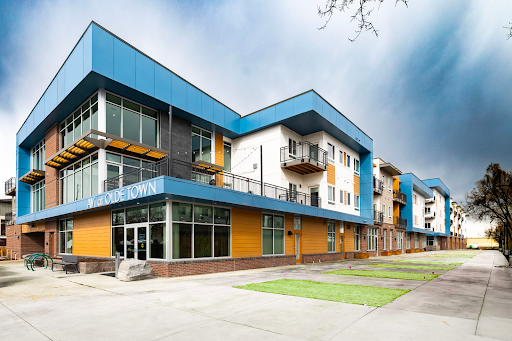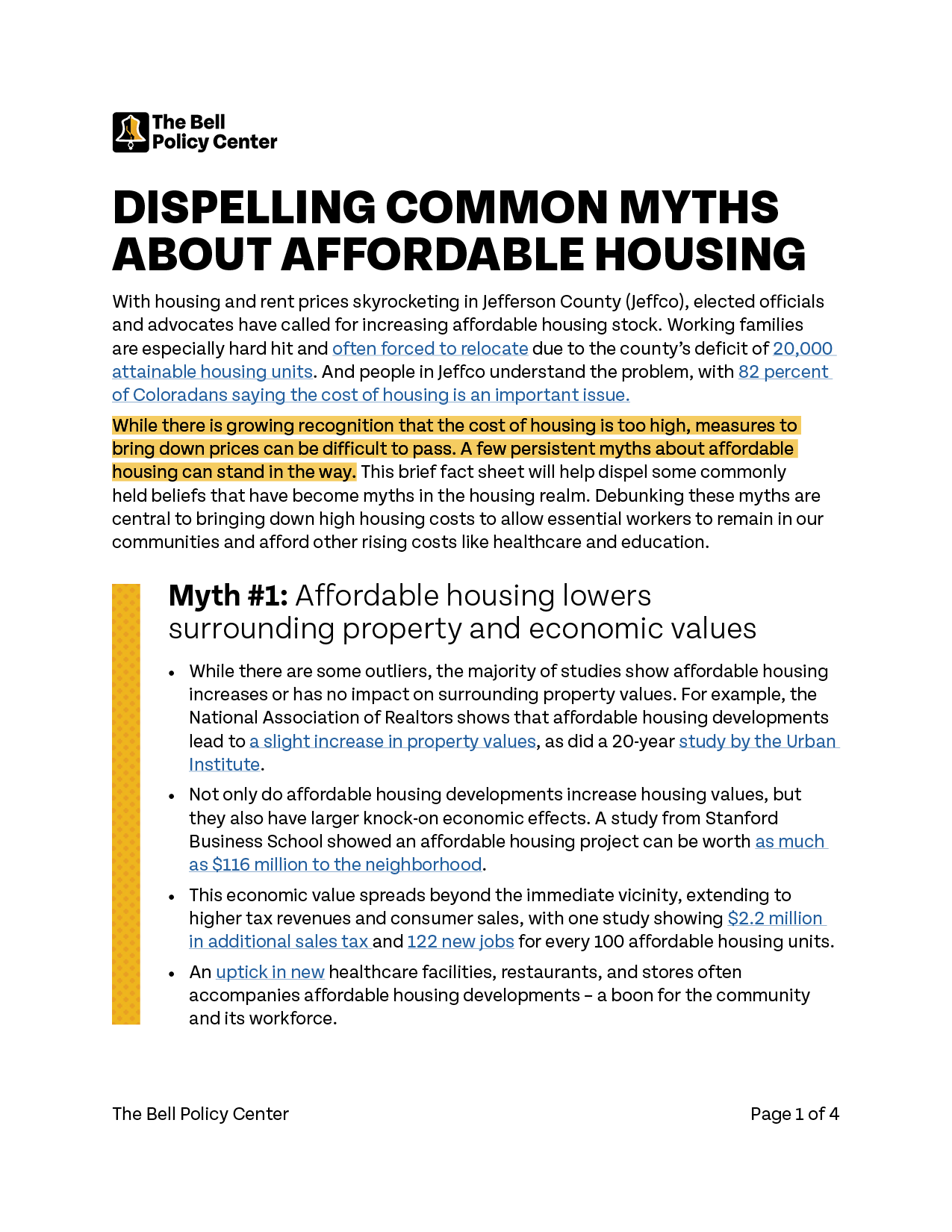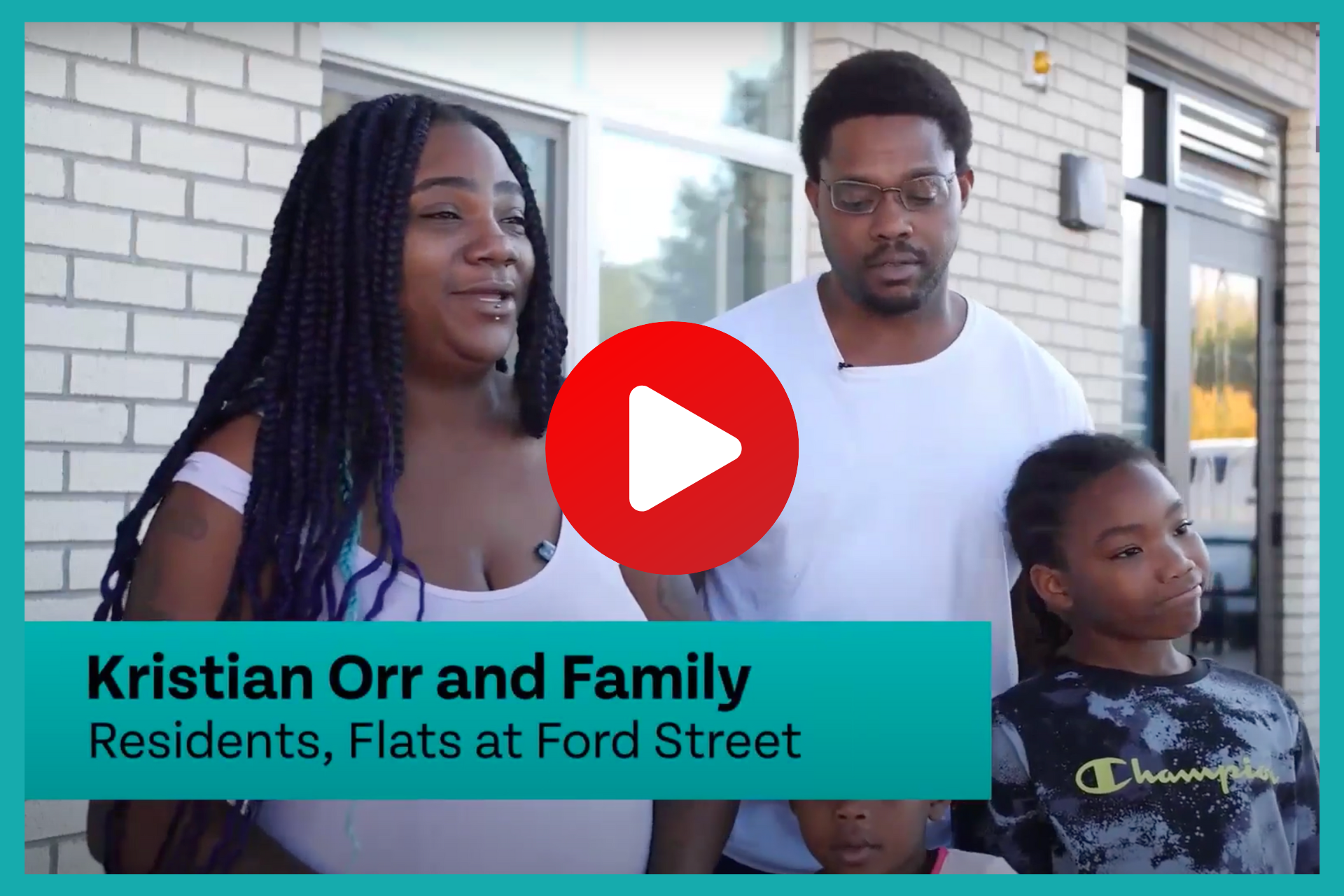Dispelling Common Myths About Affordable Housing
With housing and rent prices skyrocketing in Jefferson County (Jeffco), Colorado, elected officials and advocates have called for increasing affordable housing stock. Working families are especially hard hit and often forced to relocate due to the county’s deficit of 20,000 attainable housing units. And people in Jeffco understand the problem, with 82 percent of Coloradans saying the cost of housing is an important issue. While there is growing recognition that the cost of housing in Colorado is too high, measures to bring down prices can be difficult to pass. A few persistent myths about affordable housing can stand in the way. This brief fact sheet will help dispel some commonly held beliefs that have become myths in the housing realm. Debunking these myths are central to bringing down high housing costs to allow essential workers to remain in our communities and afford other rising costs like healthcare and education.
Myth #1: Affordable housing lowers surrounding property and economic values
While there are some outliers, the majority of studies show affordable housing increases or has no impact on surrounding property values. For example, the National Association of Realtors shows that affordable housing developments lead to a slight increase in property values, as did a 20-year study by the Urban Institute. Not only do affordable housing developments increase housing values, but they also have larger knock-on economic effects. A study from Stanford Business School showed an affordable housing project can be worth as much as $116 million to the neighborhood. This economic value spreads beyond the immediate vicinity, extending to higher tax revenues and consumer sales, with one study showing $2.2 million in additional sales tax and 122 new jobs for every 100 affordable housing units. An uptick in new healthcare facilities, restaurants, and stores often accompanies affordable housing developments – a boon for the community and its workforce.
Among the fears of negative changes brought by affordable housing are those of crime and public safety issues. The opposite is actually true. Affordable housing either decreases or does not affect crime rates. Generally, after new housing projects are built in the area, violent and property crime decreases in lower-income neighborhoods; conversely, it remains constant in higher-income neighborhoods. Rates of domestic violence also fall across the board. Overall, there is no evidence that affordable housing increases crime.
Myth 2: Affordable housing increases crime and public safety issues
Among the fears of negative changes brought by affordable housing are those of crime and public safety issues. The opposite is actually true. Affordable housing either decreases or does not affect crime rates. Generally, after new housing projects are built in the area, violent and property crime decreases in lower-income neighborhoods; conversely, it remains constant in higher-income neighborhoods. Rates of domestic violence also fall across the board. Overall, there is no evidence that affordable housing increases crime.
Myth 3: Affordable housing disrupts community character and cohesion
Affordable housing is often built to meet the housing needs of existing community members, allowing them to stay in their neighborhoods, thus promoting social cohesion. In fact, residents of new affordable housing projects are more likely to be existing workers in the community. Further, new developments have a statistically insignificant impact on neighborhood out-migration. Affordable housing developments help all types of Jeffco residents, especially those in the workforce, like teachers, firefighters, and police officers, as they, too, live in affordable housing units. These workers were essential during the pandemic and remain so.
Myth 4: Affordable housing looks cheap, damaging neighborhood aesthetics
Affordable housing is not made more affordable by using cheaper materials or cutting corners. It is made more affordable through public or private funds subsidizing its development and maintenance. In fact, these funds often require more restrictions and design standards than other housing. New affordable housing units aren’t built any differently than existing housing in the community. Developers recognize these projects will receive greater scrutiny than typical projects. This extra attention incentivizes developers to build more uniformly with the surrounding neighborhood. Recent projects in Jeffco blend into their respective communities and retain a high aesthetic value.

Myth 5: Affordable housing diminishes public school quality
Affordable housing allows families to remain in their original communities rather than face disruptive moves due to high housing costs. This results in positive outcomes for the overall student body. Young students who stay in their original elementary school have better educational outcomes; as does the overall school population, as these hypermobile children negatively impact their peers. With better educational outcomes, students achieve higher lifetime earnings. Additionally, affordable housing attracts and retains public school teachers, who otherwise struggle to remain in Jeffco.
Conclusion
Understanding the facts and dispelling these myths is one important step in unlocking Jeffco’s ability to build and develop affordable housing in Colorado. Housing development, finance, and construction are hard enough without false narratives impeding public support for affordable housing. In each case, the inverse is true. Affordable housing raises housing values. Affordable housing lowers crime and eases public safety issues. It improves community character and social cohesion. It is aesthetically pleasing and blends in with its environment. And finally, affordable housing improves school quality. Going forward, this series will explore ways we can improve housing affordability in Jeffco and its potential impact, especially for essential workers in our community.


